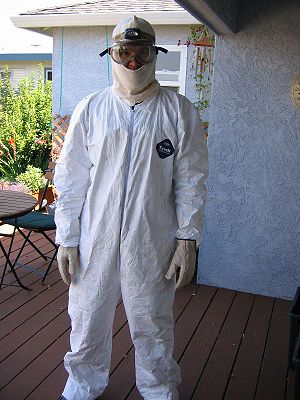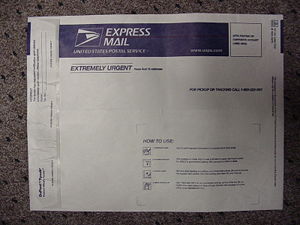Difference between revisions of "Tyvek Report"
From ThePlaz.com
(post basic outline) |
(make an extensive 1st draft) |
||
| Line 1: | Line 1: | ||
| − | [[Chemistry]] report on DuPont | + | [[Chemistry]] report on DuPont Tyvek®-brand spunbonded olefin (instructions link) |
{{Draft}} | {{Draft}} | ||
[[Category:Chemistry]] | [[Category:Chemistry]] | ||
| + | |||
| + | Tyvek® is a brand of spunbonded olefin from DuPont. It is special because it allows water vapor to pass through it while blocking liquid water and air from passing through it. Thus it allows whatever it is protecting to "breath" but still blocks water and air from reaching it. One of its most famous applications is Tyvek® HomeWrap™ where it stops wind-driven rain and bulk water from entering the house and stops air flow through wall cavities while allowing moisture to escape from interior walls. DuPont claims that it combines the best of paper, film, and cloth. It is strong, lightweight, flexible smooth, low-linting, and opaque. In addition is is resistant to certain chemicals, punctures, tears and abrasions. | ||
| + | |||
| + | other properties | ||
| + | |||
| + | different types | ||
| + | |||
| + | [[Image:John wearing Tyvek suit.jpg|thumb|Tyvek® Protection Suit]] | ||
| + | This means that it can protect many things including people, places and things. Tyvek® can be used is light-duty protection suits for hazardous environments or general, non-hazardous, industrial use. Protection is provided against water-based acids, bases, salts and splashes of certain liquids such as pesticides and herbicides. In addition protection is provided against lead dust, asbestos, and particles contaminated with radiation. The suits are light weight and disposable. Because water vapor can pass through them, the sweat can dissipate from a person's body. In addition, the low-linting properties makes Tvyek® a good choice in "clean room" applications. | ||
| + | |||
| + | [[Image:TyvekExpressMailEnvelope.jpg|thumb|USPS Tyvek® Envelope]] | ||
| + | Envelopes are also a common application of Tyvek®. They offer protection from tears, punctures, and moisture and are lightweight. FedEx® and the United Stats Post Office have been using Tyvek® envelopes for many years now. | ||
| + | |||
| + | Medical packaging uses Tyvek® because it's sterile, bacterial resistant, doesn't puncture easily, and peels off cleanly. | ||
| + | |||
| + | Tyvek® also is used to protect cars, boats, and campers. It doesn't scratch and protects against acid rain and salt sprays by blocking, not absorbing water like cotton does. Thus it is also lighter, even when wet. Also because it is breathable, it prevents rot and mildew caused by trapped water to condense and dissipate. Dirt and dust as well as particles larger then two microns can't get in to scratch car's finishes. Lastly, it blocks 98% of the sun's UV (ultraviolet rays) to protect your car when it's treated with special UV inhibitors. | ||
| + | |||
| + | Labels and papers in harsh environments can also benefit from being made of Tyvek®. For example, a wiring diagram on an air conditioner or a label on a chemical drum or food unit can be printed on Tyvek®. Marine charts, military diagrams, and field manuals also can benefit from the strength, moisture resistance and the ability to be withstand repeated flexing and folding which are provided by Tyvek®. Also Tyvek® prevents the accidental tearing and/or puncturing of these papers extending their lives in harsh environments. ?re-write? Desiccant packages can also be made of Tyvek® to allow the gas through without the harmful solids. | ||
| + | |||
| + | Some types of Tyvek® (Type 10) can be used as filters for submicrometer particles. Tyvek® can resist water, most chemicals, and its smooth surface make it a good choice as a filter. | ||
| + | |||
| + | Tyvek® when covered with a UV inhibitor can be used as the backing for signs and banners including outdoor use. | ||
| + | |||
| + | Much of the utility of Tyvek comes from the ease of use of printing on it. Tyvek® for the most part prints just like paper with offset lithography, letterpress, flexography, gravure, screen process, dot matrix, thermal transfer, ion deposition, digital press applications, and ink jet printing methods. A color match must first be made however, because colors appear slightly different on Tyvek®. In addition, Tyvek® takes longer to dry because it does not absorb water. Heat transfer printing is not recommended. Because Tyvek® can be printed on using the same methods and machines as paper, it does not require much additional equipment to print on making many of its applications possible. | ||
| + | |||
| + | |||
| + | cutting | ||
| + | |||
==Outline== | ==Outline== | ||
| Line 11: | Line 39: | ||
*like paper, film, and fabric | *like paper, film, and fabric | ||
**can be printed on | **can be printed on | ||
| − | *lightweight, strong, chemical, puncture, tear, | + | *lightweight, strong, chemical, puncture, tear, and abrasion resistant |
*used for protection of people, places and things | *used for protection of people, places and things | ||
*list other properties | *list other properties | ||
| Line 37: | Line 65: | ||
**100% high-density polyethylene | **100% high-density polyethylene | ||
***how that's made | ***how that's made | ||
| + | **made in richmond, va and luxemborg, shenzhen, china | ||
**randomly distributed and non directional fibers | **randomly distributed and non directional fibers | ||
**flash spun | **flash spun | ||
Revision as of 01:44, 11 April 2007
Chemistry report on DuPont Tyvek®-brand spunbonded olefin (instructions link)
Tyvek® is a brand of spunbonded olefin from DuPont. It is special because it allows water vapor to pass through it while blocking liquid water and air from passing through it. Thus it allows whatever it is protecting to "breath" but still blocks water and air from reaching it. One of its most famous applications is Tyvek® HomeWrap™ where it stops wind-driven rain and bulk water from entering the house and stops air flow through wall cavities while allowing moisture to escape from interior walls. DuPont claims that it combines the best of paper, film, and cloth. It is strong, lightweight, flexible smooth, low-linting, and opaque. In addition is is resistant to certain chemicals, punctures, tears and abrasions.
other properties
different types
This means that it can protect many things including people, places and things. Tyvek® can be used is light-duty protection suits for hazardous environments or general, non-hazardous, industrial use. Protection is provided against water-based acids, bases, salts and splashes of certain liquids such as pesticides and herbicides. In addition protection is provided against lead dust, asbestos, and particles contaminated with radiation. The suits are light weight and disposable. Because water vapor can pass through them, the sweat can dissipate from a person's body. In addition, the low-linting properties makes Tvyek® a good choice in "clean room" applications.
Envelopes are also a common application of Tyvek®. They offer protection from tears, punctures, and moisture and are lightweight. FedEx® and the United Stats Post Office have been using Tyvek® envelopes for many years now.
Medical packaging uses Tyvek® because it's sterile, bacterial resistant, doesn't puncture easily, and peels off cleanly.
Tyvek® also is used to protect cars, boats, and campers. It doesn't scratch and protects against acid rain and salt sprays by blocking, not absorbing water like cotton does. Thus it is also lighter, even when wet. Also because it is breathable, it prevents rot and mildew caused by trapped water to condense and dissipate. Dirt and dust as well as particles larger then two microns can't get in to scratch car's finishes. Lastly, it blocks 98% of the sun's UV (ultraviolet rays) to protect your car when it's treated with special UV inhibitors.
Labels and papers in harsh environments can also benefit from being made of Tyvek®. For example, a wiring diagram on an air conditioner or a label on a chemical drum or food unit can be printed on Tyvek®. Marine charts, military diagrams, and field manuals also can benefit from the strength, moisture resistance and the ability to be withstand repeated flexing and folding which are provided by Tyvek®. Also Tyvek® prevents the accidental tearing and/or puncturing of these papers extending their lives in harsh environments. ?re-write? Desiccant packages can also be made of Tyvek® to allow the gas through without the harmful solids.
Some types of Tyvek® (Type 10) can be used as filters for submicrometer particles. Tyvek® can resist water, most chemicals, and its smooth surface make it a good choice as a filter.
Tyvek® when covered with a UV inhibitor can be used as the backing for signs and banners including outdoor use.
Much of the utility of Tyvek comes from the ease of use of printing on it. Tyvek® for the most part prints just like paper with offset lithography, letterpress, flexography, gravure, screen process, dot matrix, thermal transfer, ion deposition, digital press applications, and ink jet printing methods. A color match must first be made however, because colors appear slightly different on Tyvek®. In addition, Tyvek® takes longer to dry because it does not absorb water. Heat transfer printing is not recommended. Because Tyvek® can be printed on using the same methods and machines as paper, it does not require much additional equipment to print on making many of its applications possible.
cutting
Outline
- DuPont
- spunbounded olefin
- water vapor passes through, but not air or liquid water
- allows "breathing"
- gets rid of condensation on houses
- like paper, film, and fabric
- can be printed on
- lightweight, strong, chemical, puncture, tear, and abrasion resistant
- used for protection of people, places and things
- list other properties
- old booklet p.4 and 5
- Commercial applications
- envelopes
- fed-ex and usps
- light-use chem suits
- resistant to what (?)
- labels in harsh places
- a/c outside
- desiccant packages
- envelopes
- medical packages
- electrical equipment
- car covers
- HomeWrap
- most famous use
- clean room suits
- low linting
- outdoor banners
- w/ uv protection
- low surface friction
- dimensionally stable up to 270 F or 132 C
- producing it
- 100% high-density polyethylene
- how that's made
- made in richmond, va and luxemborg, shenzhen, china
- randomly distributed and non directional fibers
- flash spun
- laid as a web on a moving bed
- binded w/ heat and pressure
- no chemicals or binders
- change lay down speed or bonding pressures for different thickness
- 100% high-density polyethylene
- recycling and disposal
- recycling program
- can be disposed in landfill (no chems)
- enevlopes have 30% recycled product




